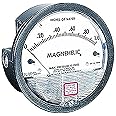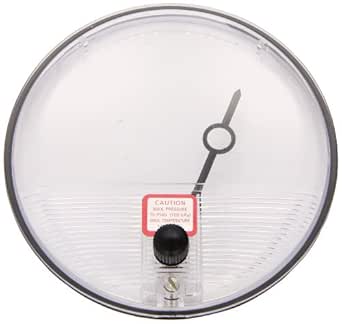In the world of HVAC (Heating, Ventilation, and Air Conditioning) systems, precise measurements and monitoring are paramount. One of the most reliable tools for ensuring optimal performance in these systems is the Magnehelic pressure gauge. This article explores the numerous advantages of using Magnehelic gauges for HVAC applications, highlighting their functionality, accuracy, and efficiency in maintaining air quality and system performance.
Understanding Magnehelic Pressure Gauges

Before diving into the benefits, it is essential to understand what a Magnehelic pressure gauge is. Developed by Dwyer Instruments, this device is a differential pressure gauge that provides accurate readings of air pressure differences in HVAC systems. It operates using a unique and robust design that allows for low-pressure monitoring in various settings.
Key Benefits of Magnehelic Pressure Gauges

- Accuracy and Precision
- Ease of Use
- Versatility in Application
- Air filters
- Duct systems
- Fan performance
- Indoor air quality monitoring
- Durability and Reliability
- Improved Energy Efficiency
- Enhanced Indoor Air Quality
Magnehelic gauges are renowned for their accuracy in measuring low differential pressures, which is crucial for HVAC systems. With a typical accuracy rate of ±2% of full scale, these gauges ensure that technicians can diagnose issues effectively and make necessary adjustments.
One of the standout features of Magnehelic gauges is their user-friendly design. The gauges are equipped with a simple dial display that allows for quick reading of pressure levels, making them accessible for technicians of all skill levels.
Magnehelic gauges can measure pressure in various applications within HVAC systems, including:
This versatility makes them a valuable tool for HVAC professionals as they can be used in different scenarios without the need for multiple devices.
Constructed from high-quality materials, Magnehelic gauges are designed to withstand the rigors of HVAC environments. Their durability means less frequent replacements, which results in cost savings for businesses and technicians alike.
By providing real-time data on air pressure, Magnehelic gauges help HVAC professionals identify areas where energy is being wasted. For example, if duct leakage is detected, technicians can take corrective measures to seal leaks, which leads to improved energy efficiency and lower utility bills.
Maintaining proper air pressure is crucial for indoor air quality. Magnehelic gauges enable HVAC technicians to monitor pressure levels in various parts of the system, ensuring that filters and ventilation systems are functioning optimally. This monitoring helps reduce contaminants and allergens in the air.
Real-World Applications and Case Studies

To illustrate the benefits of Magnehelic pressure gauges, let’s examine a few case studies where their implementation has resulted in significant improvements in HVAC performance.
Case Study 1: Hospital HVAC System

In a large hospital in California, the HVAC system was experiencing fluctuating pressure levels, causing discomfort for patients and staff. Technicians installed Magnehelic pressure gauges across various sections of the system. The results were compelling:
- Pressure readings indicated that certain areas were over-pressurized while others were under-pressurized.
- After identifying leaks in the ductwork, the team sealed them, leading to a 25% reduction in energy costs.
- Patient satisfaction scores improved due to better temperature and air quality control.
Case Study 2: Commercial Office Building

A commercial office building in New York implemented Magnehelic gauges as part of their regular maintenance routine. Over six months, they recorded:
- A decrease in HVAC maintenance calls by 30%.
- A 15% increase in energy efficiency.
- Improved air quality metrics, contributing to a healthier work environment.
Statistics Supporting Magnehelic Gauge Use
The HVAC industry has seen a growing reliance on pressure measurement tools like Magnehelic gauges. Here are some statistics that underscore their importance:
- According to the U.S. Department of Energy, improper pressure management in HVAC systems can lead to energy losses of up to 30%.
- A study by the American Society of Heating, Refrigerating and Air-Conditioning Engineers (ASHRAE) found that regular monitoring of air pressure can enhance system performance by up to 20%.
- Research indicates that maintaining optimal indoor air quality can boost employee productivity by up to 15%.
Best Practices for Using Magnehelic Gauges

To maximize the benefits of Magnehelic gauges, HVAC professionals should follow these best practices:
- Regular Calibration: Ensure gauges are calibrated periodically to maintain accuracy.
- Routine Monitoring: Schedule regular inspections to track pressure changes over time.
- Documentation: Keep detailed logs of pressure readings to identify trends and potential issues.
- Training: Provide ongoing training for technicians to ensure they can effectively use and interpret gauge readings.
Magnehelic pressure gauges are invaluable tools for HVAC systems, offering a range of benefits from enhanced accuracy and ease of use to improved energy efficiency and indoor air quality. As demonstrated through real-world applications and supported by compelling statistics, the integration of Magnehelic gauges into HVAC monitoring and maintenance routines can lead to significant operational improvements.
By investing in these gauges and adhering to best practices, HVAC professionals can ensure their systems run efficiently, providing better comfort and safety for occupants while also reducing energy costs. Ultimately, the adoption of Magnehelic pressure gauges represents a proactive approach to HVAC management, aligning with industry standards and promoting a healthier indoor environment.




